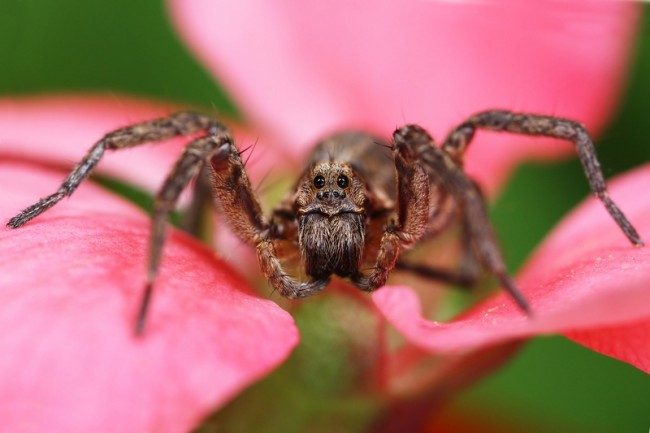A spider by any other name would still be a walking nightmare, and for many people that's exactly the case. However, most spiders are actually harmless. It's the ten species below that you really need to watch out for.
#1 – The Brazilian Wandering Spider
The Brazilian Wandering Spider is a large brown spider similar to North American Wolf Spiders, but bigger and possessing a more toxic venom. It has the most neurologically active venom of all spiders, and is regarded as the most dangerous spider in the world.
Occasional deaths have occurred even after antivenin treatment. Children have weaker immune systems, and even if antivenin is quickly administered, death can occur within minutes after the bite.#2 – The Black Widow Spider
Black widows are notorious spiders identified by the colored, hourglass-shaped mark on their abdomens. Approximately 5 percent of the reported bites were fatal prior to the invention of Widow spider antivenin.
In humans, bites produce muscle aches, nausea and a paralysis of the diaphragm that can make breathing difficult; however, contrary to popular belief, most people who are bitten suffer no serious damage—let alone death.#3 – The Brown Widow Spider
The Brown Widow spider, like its cousins the Black Widow, Red Back Spider, and Katipo are spiders that carry a neurotoxic venom which can cause a set of symptoms known as Latrodectism.
The venom of a Brown Widow, while seldom life-threatening, produces very painful effects including muscle spasms, ‘tetanus-like' contractions and, in some cases, spinal or cerebral paralysis.#4 – The Brown Recluse Spider
The Brown Recluse spider, also known as “violin spiders,” “fiddlers,” or “fiddlebacks,” from the dark violin-shaped marking on the head, are slow-moving, retiring spiders that wander about in dim areas.
The bite of a Brown Recluse is extremely venomous, and has led to fatalities through massive tissue loss and the subsequent infection. Deaths from Brown Recluse spiders have been reported only in children younger than seven years.#5 – The Six-Eyed Sand Spider
The Six-Eyed Sand Spider is a medium-sized spider found in deserts and other sandy places in southern Africa with close relatives found in both Africa and in South America.
There are no confirmed bites and only two suspected ones on record. However, in one of these cases, the victim lost an arm to massive necrosis and in the other, the victim died of massive hemorrhaging, similar to the effects of a Rattlesnake bite.#6 – The Chilean Recluse Spider
This spider is considered by many to be the most dangerous of the Recluse Spiders, and its bite is known to frequently result in severe systemic reactions, including death.
As suggested by its name, this spider is not aggressive and usually bites only when pressed against human skin. Some bites are minor with no necrosis, but a small number of bites have produced severe dermonecrotic lesions or even systemic conditions sometimes resulting in renal failure.#7 – The Northern Funnel Web Spider
These spiders are attracted to water, and often fall into swimming pools, leading to encounters with homeowners trying to scoop them out of the water.
The venom from all Funnel Web Spider species can kill a human within minutes, if no antivenin is available. This makes the Funnel Web Spider one of the most poisonous spiders in the world.#8 – The Sydney Funnel Web Spider
The long-lived female Funnel Webs spend most of their time in their silk-lined tubular burrow retreats. The males tend to wander during the warmer months of the year looking for receptive females. The Sydney Funnel Web Spider is responsible for 13 confirmed deaths between 1927–1980.
These spiders typically deliver a full envenomation when they bite, often striking repeatedly, due to their aggression and their large fangs.#9 – The Wolf Spider
The Wolf Spider is a member of the Lycosidae family, and there are around 125 species found in the U.S., and about 50 species found in Europe. A full grown Wolf Spider is typically a half an inch to two inches in length. Wolf spiders do not make webs, but actively hunt for their prey.
This spider is not known to be aggressive; however, they will bite if they feel like they are in harm or danger. They also move extremely fast when they are disturbed.#10 – The Red-Legged Widow Spider
The Red Legged Widow is a rare spider, which is a member of the Black Widow family and highly venomous. According to all literature, this spider is indigenous to south and central Florida. This colorful spider is less than an inch long, but packs the same type of venom as its other Widow relatives.
The most common symptoms are intense pain, rigid abdominal muscles, muscle cramping, malaise, local sweating, nausea, vomiting, and hypertension.
These spiders would give Ron Weasley a heart attack even if they weren't the size of cars. Being bitten by any one of them is an immediate trip to the hospital, and for a few of them, it's a one-way trip.
Keep in mind that for any spider bite, you want to either positively identify it or you want to snatch it up in a jar for identification later (you've already been bitten, you may as well squish the little jerk) so that the hospital can apply the correct treatment method immediately.
This is a terrifying list for everybody, and I hope I'm not the only one who looked under their desk while reading it. For more articles like this, check out Outdoor Life.
